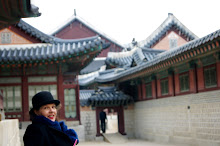William Dobell's
"Joshua Smith: Portrait of an Artist."
"It was William Dobell's prize winning portrait of fellow artist Joshua Smith in 1943, which finally broke with the conventions that had been established with the Archibald. Hunt describes the portrait as being 'haunted with vivid expressive colours, linear distortion and almost mannerist attenuation of form'.
Opposition to the win was intense and two Royal Art Society members, Joseph Wolinski and Mary Edwards, took legal action against Dobell and the Trustees, alleging that Joshua Smith was 'a distorted and caricatured form' and therefore not a portrait. In contrast, the supporters of Dobell described the portrait as both 'a likeness or resemblance of the sitter and a work of art', which allowed for distortion for the purpose of art.
Opposition to the win was intense and two Royal Art Society members, Joseph Wolinski and Mary Edwards, took legal action against Dobell and the Trustees, alleging that Joshua Smith was 'a distorted and caricatured form' and therefore not a portrait. In contrast, the supporters of Dobell described the portrait as both 'a likeness or resemblance of the sitter and a work of art', which allowed for distortion for the purpose of art.
In response to critics Dobell said that when he painted a portrait he was '... trying to create something, instead of copying something. To me, a sincere artist is not one who makes a faithful attempt to put on canvas what is in front of him, but one who tries to create something which is living in itself, regardless of its subject. So long as people expect paintings to be simply coloured photographs they get no individuality and in the case of portraits, no characterisation. The real artist is striving to depict his subject's character and to stress the caricature, but at least it is art which is alive.'
The case stimulated massive press coverage and public comment - by those both familiar and totally unfamiliar with art. Ultimately, the Dobell case became a lively debate about Modernism. The question of whether the painting was portraiture or caricature equally asked the questions of what constituted a portrait and what was the relationship of realism to art in general. Justice Roper upheld Dobell's award on the grounds that the painting, 'although characterised by some startling exaggeration and distortion... nevertheless bore a strong degree of likeness to the subject and undoubtedly was a pictorial representation of him.'"
Gosh, there's something very convoluted in this entire argument, isn't there! On one hand they're saying he wasn't trying to do a representational portrait, and on the other hand they're saying Joshua Smith was a very distorted-looking person so this is a representational portrait.
Mmmm, imagine being Joshua Smith with folks in court claiming you do indeed look like that portrait.
Thanks so much for this, Anne.





1 comment:
i am very happy after reaching this blog. i wanted to watch hbo live tv on this blog but i cannot find this on your blog.
Post a Comment